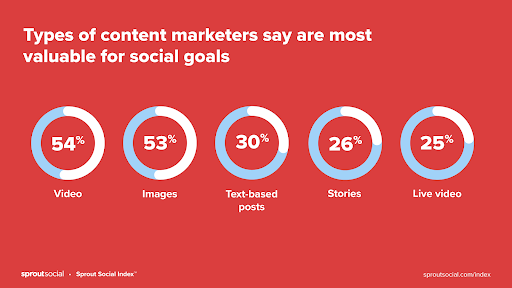When you post content online, you have the potential to grab the attention of some of the internet’s 5 billion users worldwide. However, with users uploading 1.5 quintillion bytes of content every day, your content needs to be catchy and noticeable to be seen and appreciated. Millions of websites, blogs, and social media pages are vying for user attention.
How can you stand out in this saturated marketplace? Writing basic content is not enough. Your content needs to be meaningful, structured, and appealing to attract the right audience and ensure they visit once and return to your pages. A content strategy can help you create effective content and make the process less intimidating.
A content strategy goes beyond creating an editorial calendar or publishing a blog, even one that’s packed with exciting pieces. The strategy focuses on consistently creating and distributing relevant and valuable content to attract and retain a well-defined audience and drive profitable customer action. It must align with your broader marketing plan, brand values, and business objectives.
While there is no one-size-fits-all approach to creating content, a few simple steps can put your content team on the right path.
This article highlights three tips for creating a memorable and effective content strategy. Read on to understand the topic better.
- Creating a content marketing strategy
- Assuring quality of your content
- Including visual media
1. Creating a content marketing strategy
Good content marketing starts with a robust strategy. However, according to the Content Marketing Institute’s B2B Content Marketing 2021 report, only 43% of B2B marketers have a documented content marketing strategy. This is why most marketers struggle to improve their content marketing efforts.
If you’re looking to up your content game, the first step is creating an in-depth strategy. In fact, 78% of marketers who felt their content marketing was very successful in 2021 had a documented strategy.
People create content for four main purposes: to promote, educate, inspire, or entertain. No matter the content’s purpose, you should supplement it with videos and GIFs to make it more memorable.
Here are just a few things that content can do for your online platform:
- Promote. Promotional content is used to sell your products or services to your customers directly, with the inclusion of a CTA (call to action).
- Educate. With educational content, you’ll help customers understand your offerings and what problems they solve.
- Inspire. The inspirational content category encourages people to believe and support your content. It can also explain your brand mission.
- Entertain. Entertaining content includes fun, relatable verbiage relevant to your brand. It’s also shareable and helps increase brand reach.
Use this step-by-step checklist to guide your content strategy journey:
- Define your goals
- Identify your target audience
- Audit existing content
- Determine the kind of content you want to create
- Brainstorm and create your content calendar
- Choose a content management system
- Create and publish your content
- Review content regularly
Define your goals
The first step in creating a strategy is to establish your content goals. Why are you making this content and what do you expect to achieve? Use the SMART technique to set objectives that are:
- Specific
- Measurable
- Achievable
- Relevant
- Time-based
Instead of simply saying your goal is to increase the number of leads generated, you can define your goal as generating 35% more qualified leads in the next 12 months.
Identify your target audience
To define your target audience, start by picturing your ideal customers and their personas. Try to narrow down factors like gender, age, location, interests, and lifestyle. Knowing your audience will help you determine whom you’re creating your content for and what they want or need.
Depending on your products or services, your target audience may be broad or narrow. If you sell shoes, you may cater to adults and children of all genders. However, if you sell specialized running shoes, you may have a niche brand catering to elite competitive athletes. Understanding your key demographics helps you make content that would appeal to members of your target niche.
Conduct a content audit
Before jumping into a new content strategy, take time to review your previously published content. Use data to find out which social media platforms helped you better engage with customers and what type of content they liked or shared.
Do your customers prefer snappy content on Facebook, or do they like to read case studies on LinkedIn? Involve a variety of stakeholders in this process, from your content strategists and graphics designers to salespeople and the SEO team.
Determine the kind of content you want to create
Armed with your previous performance metrics and future goals, you can decide what kind of content you want to create. Do you want to use more images or videos? Should the content be engaging or informative? This clarity will help you build on your content ideas.
Once you have clarity, you need to think about the types of content you aim to create as well as their distribution. For example, you can create social media posts for Instagram and LinkedIn, blog posts for your website—along with case studies and on-site content. While each content type has a distinct style, you can repurpose content across categories by making a few tweaks.
Brainstorm and create your content calendar
You’re now ready to create your content calendar for the coming months. A content calendar’s primary purpose is to help you schedule your posts in advance so you can be more organized and consistent.
Your content calendar can include the social media platform where your content will be posted, the date and time your content will be live, assets like copy and creative (photos or videos), and links and tags. The type of content and the frequency with which you post will depend on your social media requirements. For instance, if you have a sale on your website, promote it on your Instagram, Facebook, and Twitter posts every evening. If you have an upcoming event, host a giveaway on Instagram to create buzz.
Choose a content management system
The market has hundreds of content management systems, each with strengths and weaknesses. Basic criteria for choosing a suitable CMS include ease of use, customizability, security, pricing, and customer support. WordPress, HubSpot, and Wix are among the most popular CMS platforms.
Create and publish your content
With your content calendar and CMS in place, it’s time to publish the content you’ve created. Use content scheduling tools to make the task easier and more time-efficient. A content scheduler can prearrange social media posts to go live on multiple platforms at different times, preventing missed deadlines. SocialBee, Agorapulse, and Missinglettr are some of the most popular content schedulers.
Pro tip: Ensure you have a copy editor proofread the pieces before they go live. Find more information on this in the following sections.
Review content regularly
Don’t forget to review your content from time to time and measure it against the goals you set. Be flexible and update your content strategy if an aspect of it isn’t working as expected.
A content strategy helps you plan your marketing activities for the coming months. Moreover, it also helps you dedicate resources accordingly, resulting in a more efficient workflow. For instance, if you need to create 40 blog posts in one month, you’ll likely need to allocate two content writers and one graphic designer to work on them.
2. Assuring quality of your content
The internet has no shortage of content. You must focus on quality over quantity to set yourself apart. Writing great content can help you get more visitors, reduce bounce rates, and increase conversions. Here’s how to create relevant content that appeals to users and search engines alike.
Write for your users
High-quality content must be useful to your audience and contain the information they seek. You can conduct keyword research and use Google Analytics to determine what is helpful to your target audience.
Keyword research will also give you insights into the words you should include in your content to improve your rankings. As more users visit your site and bounce rates decrease, search engines will rank your web page more favorably.
Make your content easy to read
Quality content is well-structured and gives the user information without being overwhelming. Avoid using lengthy sentences or complicated language, making it harder for readers to grasp concepts. Using variations in tone and synonyms makes written content more interactive and engaging. Don’t forget to add some personality to your piece of content; users need to know what makes your brand unique.
Proofread and edit your content
Grammar, punctuation, formatting, and spelling mistakes can significantly affect your users’ reading experience. Content that is full of errors can hurt your brand’s image and authority, making users less likely to trust you.
Beyond typos, you should also check that your content conveys the intended message.
Consider these two sentences:
“You will be required to work twenty four-hour shifts.”
“You will be required to work twenty-four-hour shifts.”
Though similar in structure, the above sentences have entirely different meanings.
Working with a copyeditor can help ensure your content is free of grammatical errors. These professionals are experts at improving the syntax and readability of content pieces and can adapt the writing style to suit the target audience.
If your content is about a specialized topic like law or data science, you can also benefit from hiring a technical writer to check for factual accuracy. This will save you from the embarrassment of publishing inaccurate content and protect your reputation as a brand. You can use Ndiwano.com to hire a technical writer who can write or edit your content.
Update your content regularly
Help users find the right information and earn their trust by editing published content to ensure it’s accurate. Check links and fix any that no longer function. Moreover, updating your website, white papers, and blog posts shows search engines that your page is active and deserves a good SEO ranking, increasing organic traffic.
3. Including visual media
Visuals effectively convey a message faster and clearer than written content. In fact, 94% of marketers believe videos increase understanding of a product or service. Today, content strategists have a wide range of content formats to choose from: images, GIFs, podcasts, animations, infographics, 360-degree videos, and more.
In a recent marketing survey, video content was voted the most valuable for achieving social goals (54%), followed by images (53%) and text-based posts (30%).

The challenge of creating media content
Visual media content can be very beneficial in grabbing the audience’s interest. However, many marketers find creating visual content demanding. The common pain points include a lack of skill, time, or resources. Forty-three percent of marketers say their biggest challenge while producing engaging video content is to make it consistently, while 22% struggle with creating great design.
A simple way to include visuals is to assign featured images to your written content. They are a great way to grab users’ attention, add visual interest, and give a sneak peek into the article. These can range from stock photos to illustrations, charts, or word art.
How to use stock imagery
While stock photos are an easy and convenient option to meet your visual content needs, they can also come across as too generic. Here is a free stock image, downloaded from Unsplash. It has over 3 million views and 24,000 downloads.

Photo by Milo Miloezger on Unsplash
Search for this image on Google and you’ll find that hundreds of websites are using it.

While the photo in question is of high quality and relevant to the content, its frequent appearance on the internet makes it hard for any brand to use it to capture the viewer’s interest.
On the other hand, by adding unique brand elements to stock photos, you can create memorable visual content. This customization can take them from generic images to personalized and relevant photos related to your marketing goals.
The creative brand Amy Shamblen took a regular stock photo of a work desk and turned it into something unique by adding a screenshot of its Instagram page on the work screen. This elevated the stock photo from a generic template to something distinctive and helped boost brand awareness.

Photo from amyshamblen.com
An independent graphic designer or illustrator can customize stock images according to your marketing campaigns or create unique graphics for your landing page.
Reuse and recycle content
Visual media can also help you repurpose content, which reduces the pressure of creating new content every month. Here’s an example of how to do it.
Let’s say you conduct a survey about the top five publishing tools marketers like to use. You can turn this data into a pie chart, an animated video, an infographic, and a carousel for social media; the possibilities are endless.
Get content strategies from top-rated professionals
In today’s content-driven world, brands must invest in a dynamic content creation strategy. However, creating a content plan can be challenging. While working on content production, you must keep multiple factors in mind and constantly adapt to the changing media landscape.
Ndiwano.com can help you find talented content marketers and content marketing agencies to help with all facets of content marketing. From creative graphic designers and video editors to content editors and digital marketing strategists, you can find the right independent professional in three steps:
- Browse. Once you know your requirements, browse through the extensive list of relevant professionals and pick the one that suits your needs and budget.
- Buy. Next, share your requirements and confirm the project; the professional will complete the work in the given timeline.
- Approve. Review the deliverables and ask the professional to make changes (if any). Once you’re satisfied with the results, pay the professional for their work.
A good content strategy can set your brand up for success, improve user experience, and help you meet your business goals. If you’re new to content marketing, there’s no need to be intimidated. Explore Ndiwano.com’s content marketing solutions to get started.
If you’re a content marketing professional, use Ndiwano.com to find your next freelance content marketing job.



Leave your comment
You must be logged in to post a comment.